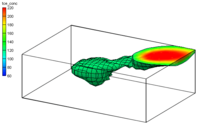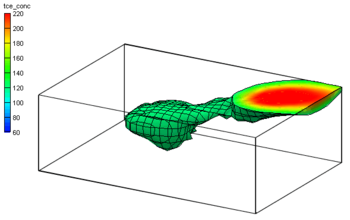GMS:3D Scatter Point Module: Difference between revisions
No edit summary |
No edit summary |
||
| (11 intermediate revisions by the same user not shown) | |||
| Line 1: | Line 1: | ||
{{3D Scatter Point links}} | {{3D Scatter Point links}} | ||
The 3D Scatter Point module is used to interpolate from groups of 3D scatter points to meshes, grids, or TINs. Several interpolation schemes are supported including [[GMS:Kriging|kriging]]. | The 3D Scatter Point module is used to interpolate from groups of 3D scatter points to meshes, grids, or TINs. Several interpolation schemes are supported including [[GMS:Inverse Distance Weighted|inverse distance weighted interpolation]] and [[GMS:Kriging|kriging]]. | ||
[[GMS:Interpolation|Interpolation]] is useful for setting up input data for analysis codes and it is also useful for site characterization. | [[GMS:Interpolation|Interpolation]] is useful for setting up input data for analysis codes and it is also useful for site characterization. | ||
:[[Image:Sample_Interp.png|thumb|none|left|350 px|Interpolation of TCE data to a 3D grid]] | :[[Image:Sample_Interp.png|thumb|none|left|350 px|Interpolation of TCE data to a 3D grid]] | ||
A number of [[GMS:3D Scatter Point Tool Palette|tools]] are included for creating and manipulating 3D scatter point sets. In general, 3D scatter sets are imported using the [[GMS:File Import Wizard|''File Import Wizard'']]. 3D scatter sets can also be created from other objects in GMS such as GIS objects, feature objects, meshes, grids, TINs, etc. | |||
Multiple 3D scatters sets can be in the module. Existing scatter sets can be duplicated or merged together. | |||
Besides interpolating 3D scatter sets to other data, the module can also be used to create objects from the scatter data. | |||
The module contains its own [[GMS:3D Scatter Point Display Options|display options]] which include contour displays. Also, each scatter point has an [[GMS:Active/Inactive Points|active/inactive]] status. A scatter point with an inactive status can be displayed, but the dataset value at the point is ignored when interpolation takes place. | |||
The 3D Scatter Point module also allows exporting scatter sets by right-clicking on the scatter set and selecting the '''Export''' command. Options for export include: Text Tab Deliminated 3D Scatter Point Files (*.txt), Text GMS 3D Scatter Point Files (*.xyz), and Shapefiles (*.shp). | |||
{{Navbox GMS}} | {{Navbox GMS}} | ||
[[Category:3D Scatter Point]] | [[Category:3D Scatter Point|scatter]] | ||
[[Category:Interpolation]] | [[Category:Interpolation|3]] | ||
[[Category:Scatter Modules]] | |||
Latest revision as of 15:43, 17 November 2016
The 3D Scatter Point module is used to interpolate from groups of 3D scatter points to meshes, grids, or TINs. Several interpolation schemes are supported including inverse distance weighted interpolation and kriging.
Interpolation is useful for setting up input data for analysis codes and it is also useful for site characterization.
A number of tools are included for creating and manipulating 3D scatter point sets. In general, 3D scatter sets are imported using the File Import Wizard. 3D scatter sets can also be created from other objects in GMS such as GIS objects, feature objects, meshes, grids, TINs, etc.
Multiple 3D scatters sets can be in the module. Existing scatter sets can be duplicated or merged together.
Besides interpolating 3D scatter sets to other data, the module can also be used to create objects from the scatter data.
The module contains its own display options which include contour displays. Also, each scatter point has an active/inactive status. A scatter point with an inactive status can be displayed, but the dataset value at the point is ignored when interpolation takes place.
The 3D Scatter Point module also allows exporting scatter sets by right-clicking on the scatter set and selecting the Export command. Options for export include: Text Tab Deliminated 3D Scatter Point Files (*.txt), Text GMS 3D Scatter Point Files (*.xyz), and Shapefiles (*.shp).
GMS – Groundwater Modeling System | ||
|---|---|---|
| Modules: | 2D Grid • 2D Mesh • 2D Scatter Point • 3D Grid • 3D Mesh • 3D Scatter Point • Boreholes • GIS • Map • Solid • TINs • UGrids | |
| Models: | FEFLOW • FEMWATER • HydroGeoSphere • MODAEM • MODFLOW • MODPATH • mod-PATH3DU • MT3DMS • MT3D-USGS • PEST • PHT3D • RT3D • SEAM3D • SEAWAT • SEEP2D • T-PROGS • ZONEBUDGET | |
| Aquaveo | ||

